In today’s world, we’re bombarded with different diet advice. This can make us feel lost and unsure about what to eat. But, starting a healthier lifestyle doesn’t have to be hard. By following simple nutrition tips, we can make eating a fun and natural part of our lives.
It’s important to remember that simple nutrition isn’t about strict rules. It’s about making small, lasting changes. This guide will show you easy diet hacks that fit into your daily routine. These changes can boost your health and happiness without the stress of complicated rules1.
Key Takeaways
- Simple nutrition tips can lead to a healthier lifestyle without overwhelming us.
- Making small dietary changes can significantly impact our overall wellness.
- Focus on sustainable eating practices rather than restrictive diets.
- Nutrition should feel intuitive and enjoyable, not stressful.
- We can implement easy diet hacks into our everyday routines.
Understanding Simple Nutrition
Seeking a healthier lifestyle often leads us to simple nutrition. It focuses on minimalism, balance, and easy access to healthy foods. This approach makes it simpler to make good food choices, leading to better health.
What Is Simple Nutrition?
Simple nutrition is all about keeping things simple in our diet. It tells us to eat whole, unprocessed foods and avoid foods that are bad for us. Eating too much of the wrong foods can lead to serious health problems2.
Simple nutrition offers clear rules for making tasty, healthy meals. This makes it easier to enjoy eating well.
Benefits of Simplifying Your Diet
Simple eating has many advantages. It lowers stress and helps us eat more mindfully, leading to better choices3. It also keeps our gut healthy, helps with weight, and fights off diseases2.
Using the MyPlate Model is a great way to start. It suggests eating half of our meals as veggies and fruits. This helps us get the right mix of nutrients for good health.
| Principles of Simple Nutrition | Benefits |
|---|---|
| Focus on whole foods | Reduced health risks and better overall nutrition |
| Limit processed foods | Decreased likelihood of chronic diseases |
| Emphasize balance | Promotes satisfaction and sustained energy |
| Practice mindful eating | Improved food choices and reduced intake |
Eat More Whole Foods
Adding more whole foods to our diets is key to better health. Whole foods are natural and unprocessed. They include fruits, vegetables, nuts, seeds, and legumes. These foods are great alternatives to processed ones.
By choosing whole foods, we nourish our bodies. We also lower the risk of chronic diseases.
What Are Whole Foods?
Whole foods are in their natural state, without artificial additives. They keep essential nutrients and fiber that processed foods often miss. For example, eating more fruits and vegetables can lower cancer and heart disease risks4.
Unlike ultra-processed foods, whole foods are good for our hearts4.
How Whole Foods Improve Health
Eating whole foods daily brings many health benefits. People who eat more plants have a 19% lower risk of heart disease death5. Whole food diets also lower type 2 diabetes and stroke risks5.
A study showed those on whole-food diets lost 10 pounds in six months. Those eating processed foods gained weight5. This shows why we should choose whole foods over processed ones.
Portion Control Is Key
In today’s fast world, we often forget about portion control. It’s key for healthy eating. Obesity is a big problem, and many struggle to lose weight6. Since the late 1980s, fast food portions have grown a lot. We need to rethink how we serve food6.
Using Smaller Plates
Using smaller plates is a good way to control portions. Research shows big plates can make us eat more and feel full later6. Smaller plates make food seem bigger, helping us eat less and feel more satisfied.
Understanding Ideal Portion Sizes
We need to know what’s a good portion size. Here are some guidelines:
| Food Group | Recommended Serving Size | Calories |
|---|---|---|
| Cooked Pasta or Rice | 1/2 cup (75-100 grams) | Approximately 100-150 calories |
| Vegetables & Salad | 1-2 cups (150-300 grams) | 25-50 calories |
| Breakfast Cereal | 1 cup (40 grams) | Approximately 150 calories |
| Cooked Beans | 1/2 cup (90 grams) | Approximately 100 calories |
| Nut Butter | 2 tablespoons (16 grams) | Approximately 190 calories |
| Cooked Meats | 3 ounces (85 grams) | Approximately 200-250 calories |
Knowing these sizes helps us eat right. Keeping a food diary can also help us lose weight by being more aware of what we eat7.
By controlling portions and knowing serving sizes, we can eat healthier and stay well for a long time6.
Prioritize Fresh Fruits and Vegetables
We should make fresh fruits and vegetables a big part of our meals. They are full of antioxidants, which are good for our health. The American Heart Association says to fill half our plate with them. This matches the USDA MyPlate guidelines for 5-9 servings a day89.
The Importance of Antioxidants
Antioxidants fight oxidative stress in our bodies. They help prevent heart disease and some cancers. Eating more fruits and vegetables rich in carotenoids can protect our hearts109.
Health Benefits of a Colorful Plate
A colorful plate makes our meals look good and gives us more nutrients. Eating a variety of colors means we get lots of vitamins and minerals. Eating at least five servings a day can lower cancer and stroke risks109.
Choosing healthy snacks like pre-cut veggies and fruits is easy. They help us meet our daily goals and add fun colors and tastes to our meals8.
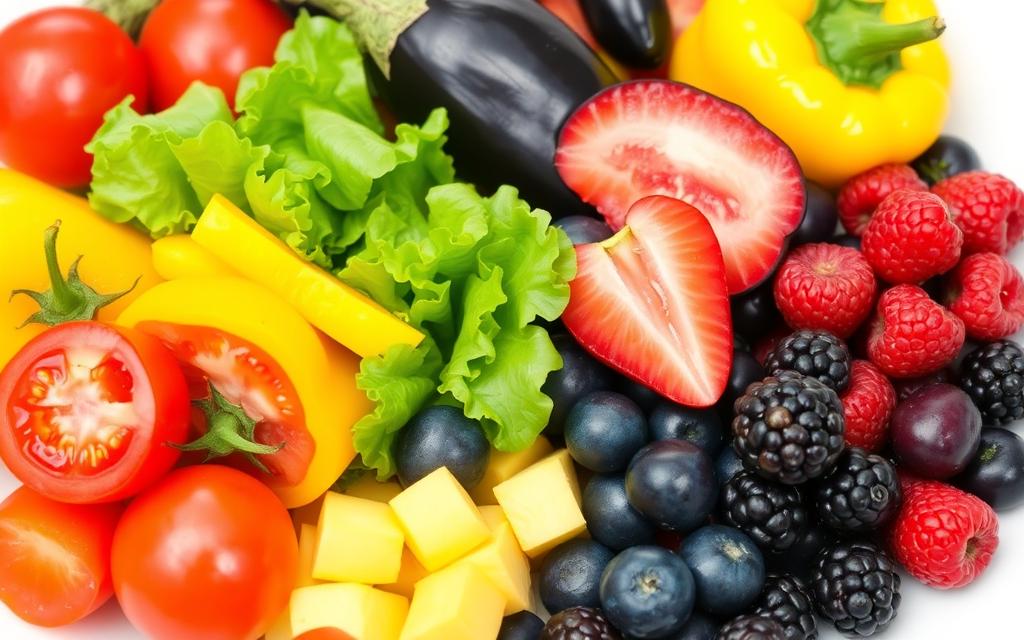
Make Simple Swaps
Making simple swaps in our meals can greatly improve our health. These changes are easy and don’t need big adjustments. For example, choosing whole grains over refined ones can lower diabetes and heart disease risks by 20 to 30 percent11. Whole grains like quinoa have more protein, fiber, and nutrients than regular pasta12.
Choosing Whole Grains Over Refined
Switching to whole grains is a simple yet powerful choice. For instance, steel-cut oats have more fiber than instant oats, helping manage blood sugar better11. Also, using whole grain bread instead of white bread adds important nutrients and cuts down on refined carbs. These simple swaps not only boost health but also add variety to our meals.
Finding Healthier Snack Alternatives
We can make our snacks healthier by choosing healthy snacks. For example, swapping high-sugar granola bars for nuts or homemade kale chips is a smart move. These snacks are low in calories but packed with nutrients13. Plus, making snacks at home means avoiding preservatives found in store-bought ones, getting us closer to real, nutritious foods12.
| Traditional Option | Healthier Swap | Health Benefits |
|---|---|---|
| Regular Soda | Kombucha | Reduces calorie intake by approximately 33%13 |
| Fried Potato Chips | Baked Snack Chips | Lower fat content |
| Iceberg Lettuce | Dark Leafy Greens | Rich in vitamins A and C |
| Sour Cream | Greek Yogurt | Protein-rich alternative for dips |
| White Bread | Whole Grain Bread | Higher nutritional value |
These changes not only make our meals better but also help us live healthier. By making simple swaps, we can cut down on bad calories, fat, sugar, and salt. At the same time, we increase our nutrient intake131112.
Plan Your Meals in Advance
Adding meal planning to our weekly routine can greatly boost our health. By planning our meals, we avoid quick takeout that often leads to unhealthy eating. A busy life often pushes us towards these easy foods, making meal planning key to staying healthy.
The Benefits of Meal Planning
Meal planning has many benefits that fit well with a healthy eating plan. Preparing meals ahead saves time and money and helps with weight control. By controlling what we eat, we see big improvements in our diet. Studies show that up to 60% of U.S. adults prep meals weekly, saving 2-3 hours each week14.
Shopping with a meal plan can also cut grocery bills by 15-20%14. This method reduces stress about what to eat, as 25% of adults feel stressed about meal prep14.
How to Create a Weekly Menu
Creating a simple weekly menu is easy. Start by setting aside specific days for certain meals, like Meatless Mondays or Stir-Fry Fridays. This adds structure and consistency to our eating. Proper storage of meals can cut down food waste by 30%14.
Make sure to check the expiration dates of stored foods. Cooked meats should be eaten within 3-4 days, and beans in up to 5 days14. With good planning, we can eat well and save time.
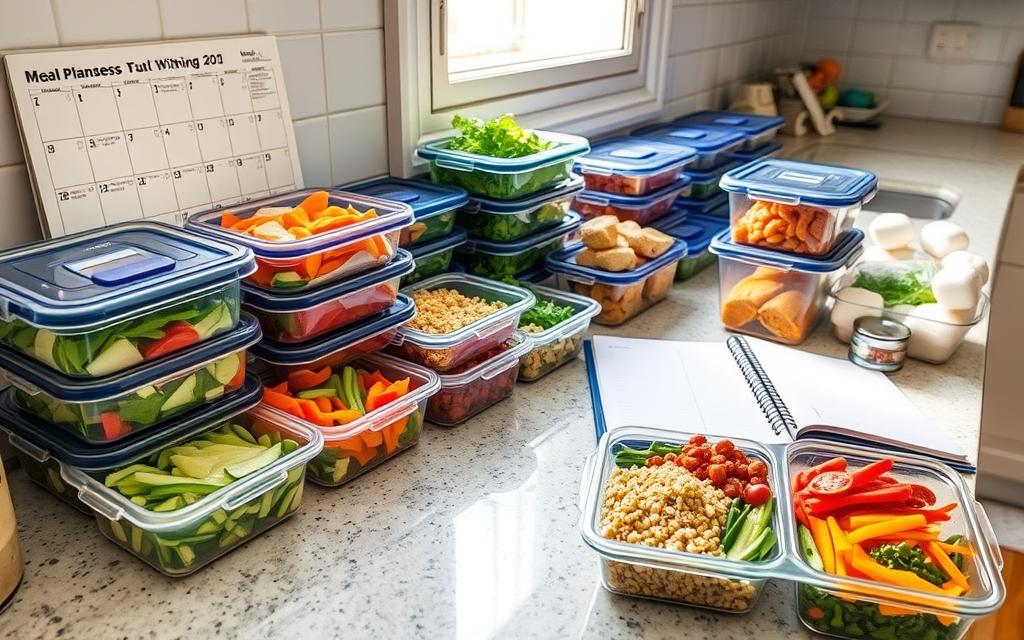
| Meal Type | Caloric Content | Healthier Alternative | Calories |
|---|---|---|---|
| Typical Fast Food Burrito | Over 1,000 | Grilled Chicken with Vegetables | Less than 750 (or under 500 without rice) |
| Traditional Diner Breakfast | Approximately 700 | Balanced Breakfast with Fruits and Whole Grains | About 400 |
| Standard Restaurant Meal | 1,500 | Balanced Meal with Variety | Around 700 |
By using these meal planning tips, we set ourselves up for success in our nutrition journey15.
Simple Nutrition Hacks: Eat Your Greens First
Starting meals with vegetables is a great nutrition hack for better health. It’s a simple change that can make a big difference. Eating greens first boosts our nutrition intake and makes meals more satisfying.
Why Start with Vegetables?
Eating veggies first can change how we digest food. Studies show starting with veggies can cut calorie intake by 20% in later meals16. This helps us feel full without eating too much of heavy foods. It also helps manage blood sugar levels by slowing down carb absorption17.
Influence on Nutritional Intake
Starting with greens promotes better eating habits and supports our nutritional goals. Only 10% of Americans eat enough veggies, which is about 2.5 cups a day18. By eating greens first, we’re more likely to meet this goal and might eat fewer calories. Planning meals in advance can also lead to eating 12% fewer calories16. This simple habit can greatly improve our health.
| Benefit | Description |
|---|---|
| Increased Satiety | Eating greens first can help us feel fuller, leading to reduced calorie intake. |
| Improved Blood Sugar Control | Vegetables eaten before carbs help slow their absorption into the bloodstream. |
| Enhanced Nutritional Intake | Starting with vegetables increases the likelihood of meeting daily vegetable recommendations. |
| Lower Caloric Consumption | Individuals eating veggies first tend to consume fewer calories overall. |
Hydration: The Often Overlooked Element
Hydration is key to our health, but we often overlook it. Our bodies are about 60% water, showing its vital role in keeping us healthy19. Drinking enough water helps our bodies work right, boosts our brain power, and improves how we perform physically.
Benefits of Drinking Water
The benefits of water are many. Even a small amount of dehydration can hurt our memory, mood, focus, and quickness20. Drinking water also helps us handle heat better, which can prevent heat sickness20. It helps our body get rid of waste, like through pee and sweat20.
Drinking more water can also help us lose weight. Studies show that drinking water before meals can lead to less weight and better body shape in women who are overweight20.
Creative Hydration Alternatives
We can make drinking water fun with creative ideas. Instead of sugary drinks, try infused water or herbal teas19. Adding fruits like lemon, berries, or cucumber to our water makes it taste good without extra sugar. This keeps us hydrated and adds important nutrients to our diet.
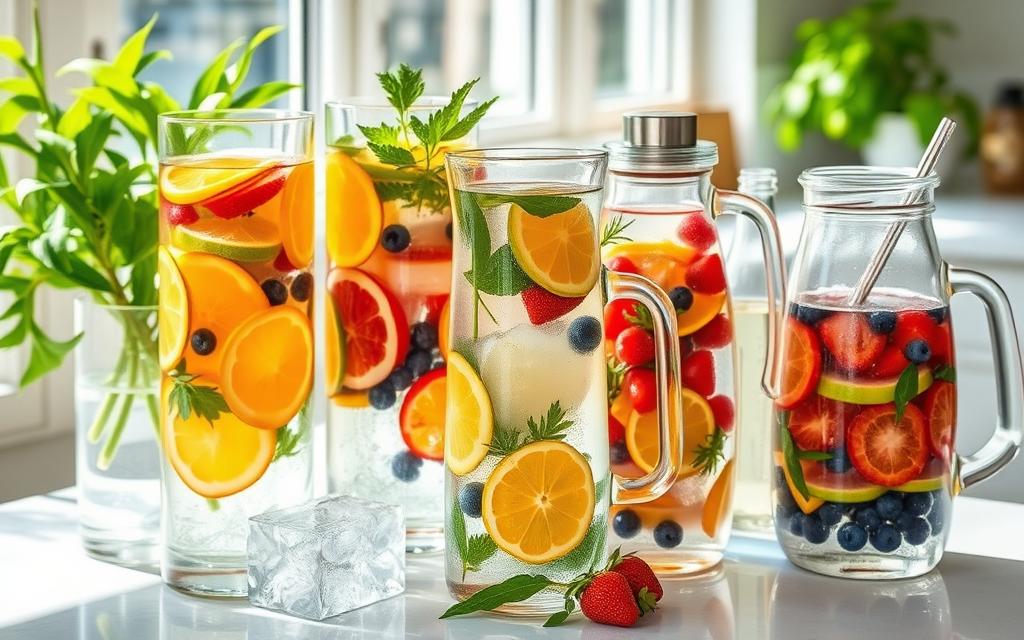
Cook at Home More Often
Cooking at home has many benefits. It improves our cooking skills and helps our health and wallet. By cooking at home, we can make meals that fit our tastes and save money.
Cost-Effective Cooking
Cooking at home can save you money. People who cook at home save about $60 a month compared to eating out21. Restaurants often serve too much food, leading to overeating and spending more21.
By controlling how much we eat at home, we can save money and eat healthier. This helps prevent food from going to waste.
Boost Your Cooking Skills
As we cook more at home, our skills get better. Studies show that home cooks eat more fruits and veggies, up to 160 grams more daily22. This leads to healthier eating and a lower risk of being overweight by 28%22.
Cooking also boosts our mental health. It gives us a creative outlet, reduces stress, and brings us closer to family during meals.
Try New Recipes for Variety
Adding new recipes to our meals brings excitement and variety. This is key for a healthy diet. We suggest trying one to two new recipes each week. This can lead to 8 to 16 new dishes in just two months23.
This approach not only adds to our cooking variety. It also helps avoid food boredom, which can lead to unhealthy choices23. Introducing fresh herbs and flavors makes our meals more enjoyable. It does this without adding extra calories.
Benefits of Experimenting in the Kitchen
Exploring new recipes in the kitchen has many benefits. With over a million cookbooks, we have a vast source of healthy recipes. Starting with five days of new recipes might seem daunting23. But, the joy and excitement in cooking make it all worth it.
Trying different ingredients like avocado, shrimp, and various proteins boosts our diet’s nutrition. For example, Garlic Lime Shrimp has 309 calories and 19g of protein24.
Sources for Healthy Recipe Ideas
There are many places to find inspiration for healthy recipes. Cookbooks are still a great source, even with digital platforms growing. Social media is full of creative ideas and new dishes to try.
Blogs and websites focused on healthy recipes offer valuable insights and new cooking methods. For easy protein-rich meals, Black Bean Chicken with Rice is a good option, with 32g of protein per serving24.
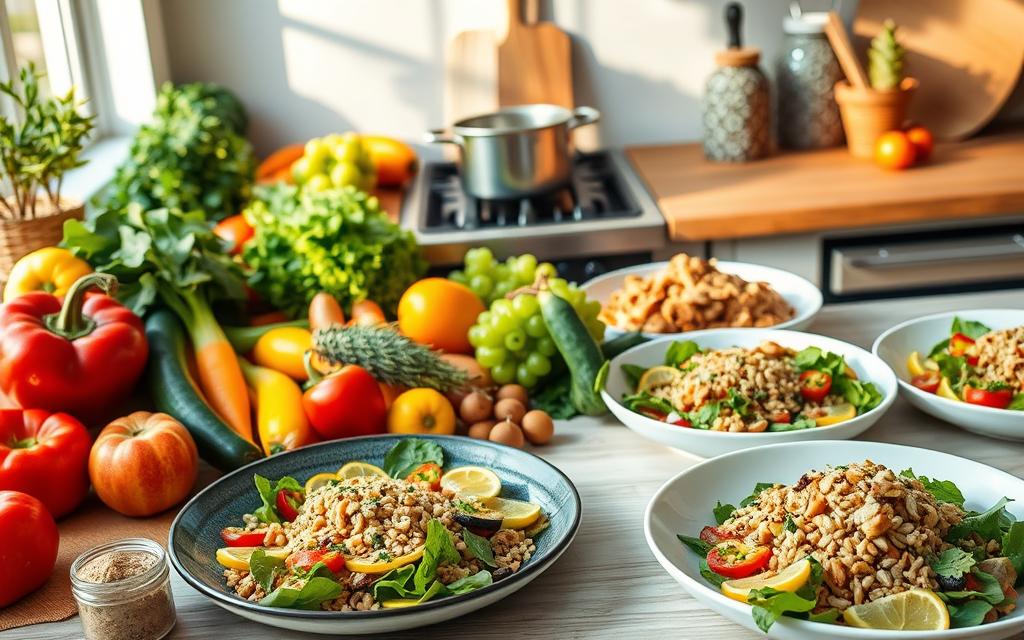
| Recipe | Calories | Protein (g) |
|---|---|---|
| Avocado Crab Boats | 325 | 13 |
| Garlic Lime Shrimp | 309 | 19 |
| Grilled Chicken Salad | 455 | 24 |
| Black Bean Chicken with Rice | 400 | 32 |
| Spinach Shrimp Fettuccine | 283 | 17 |
By embracing cooking variety through these healthy recipes, our meals become both nutritious and tasty. Diversifying our cooking helps us enjoy a more satisfying and healthy culinary journey.
Increase Your Protein Intake
Protein is key to a healthy diet. It helps keep muscles strong, boosts our immune system, and keeps us full. For a 145-pound person, about 52 grams of protein a day is recommended25.
Why Protein Matters
Protein is vital for our health. It makes us feel full and satisfied. Eating protein from different sources gives us fats, carbs, vitamins, and minerals25.
Experts say to eat 25-30 grams of protein at each meal. Snacks should have 10-15 grams for best results25.
Easy Protein-Rich Foods to Incorporate
Adding protein-rich foods to our meals is simple and tasty. Here are some great options:
- Beans and legumes like lentils
- Dairy products such as Greek yogurt and cheese
- Lean meats, including chicken and fish
- Eggs, which provide about 19 grams of protein per three large eggs26
- Nuts and seeds, such as almonds and sunflower seeds
- Soy products, including tofu and tempeh
Knowing the protein in common foods helps us choose better. For instance, Greek yogurt has about 10 grams of protein per 3.5 ounces, double that of regular yogurt26. A 3-ounce T-bone steak has 21 grams of protein26. Paying attention to protein helps keep muscles strong and improves health.
Mindful Eating Practices
Mindful eating is key to healthier eating habits. It teaches us to enjoy our meals slowly and notice our hunger and emotions. Studies show it can change bad eating habits, like emotional and binge eating, and help avoid obesity27.
The Importance of Slowing Down
Eating slowly can greatly improve how we eat. A study found that mindful eating helps us feel full faster and eat less27. People who ate slower ate less and felt full sooner27.
It can also help with weight loss. Women in a 12-week mindful eating program lost about 4 pounds (1.9 kilograms)28.
Avoiding Distractions While Eating
Eating without distractions is crucial for mindful eating. Mindfulness can reduce emotional and binge eating, often caused by stress28. People who practiced mindful eating saw big improvements, like fewer binge eating episodes28.
By focusing on our meals and stopping when we’re 80% full, we can avoid overeating. This builds a healthier relationship with food27.
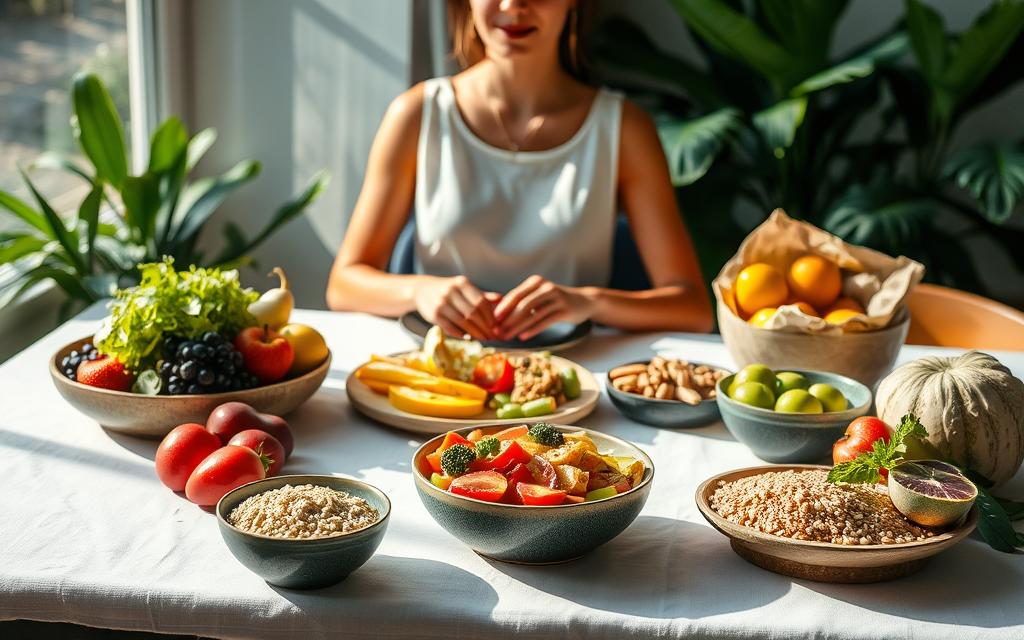
Simple Nutrition: Avoid Processed Foods
We need to examine the foods we eat for better health. It’s key to know the difference between processed and whole foods. Processed foods have long lists of ingredients, often with salt, sugar, and preservatives that harm us. Whole foods, on the other hand, are simple and packed with nutrients.
Understanding Processed vs. Whole Foods
In the U.S., about 60% of our calories come from ultra-processed foods29. These include bread and frozen meals, which are big in our diet29. These foods are often empty of nutrients and can cause obesity, diabetes, and heart disease because of their sugar and lack of fiber29. But, whole grains and foods that are not heavily processed are safer for our health30.
Health Risks Associated with Processed Foods
Eating too much processed food can harm our health. For example, sugary drinks increase the risk of obesity, diabetes, and heart disease29. Also, processed meats are linked to cancer, showing their dangers30. To eat better, we can switch to healthier foods like whole-grain bread and low-sugar cereals30.
Conclusion
As we wrap up our look at simple nutrition hacks, it’s key to think about how these tips can change our eating habits. We’ve talked about the value of *whole foods*, being mindful, and choosing fresh produce. These steps can really boost our health.
Recent studies show that almost 40% of people are cutting down on added sugars. This shows a big move towards healthier eating31. It’s a sign that people are making better choices for their health.
Also, efforts like the WHO’s goal to get rid of trans fats are in line with our goal for a healthier world. By planning meals and trying new recipes, we can make our diets better in a lasting way32. Starting small makes it easier to make lasting changes for better health.
So, let’s all start using these simple nutrition tips in our daily lives. Small changes, like eating greens first or choosing whole grains, can make a big difference in our health. By making informed choices, we improve our health and help achieve bigger health goals3132.
FAQ
What is simple nutrition?
Simple nutrition is about eating healthy in a simple way. It’s about choosing whole foods, controlling portions, and eating mindfully. This makes it easier to eat well every day.
How can whole foods improve my health?
Whole foods are foods that are not heavily processed. They keep their nutrients. Eating these foods can lower the risk of diseases and boost our immune system.
Adding fruits, veggies, nuts, legumes, and whole grains to our meals can greatly improve our health.
What portion sizes should I be using?
Start by using smaller plates to feel full with less food. Portion sizes vary, but aim for half your plate to be fruits and veggies. A quarter should be lean proteins, and another quarter whole grains.
Why is it important to eat a variety of fruits and vegetables?
Eating a variety of fruits and veggies gives us lots of antioxidants and nutrients. Different colors offer different health benefits. This helps prevent diseases and boosts our energy.
How can meal planning help with healthy eating?
Meal planning helps us prepare healthy meals ahead of time. It stops us from eating impulsively and keeps our kitchens stocked with good food. It helps us make better choices, save money, and waste less food.
What are some alternative drinks to improve hydration?
Instead of just water, try herbal teas and infused waters. Add fruits or herbs for flavor without sugar. These drinks help us stay hydrated and taste good.
How can I incorporate more protein into my diet?
Add protein-rich foods like dairy, beans, lean meats, and nuts to your meals. This makes you feel full longer and helps keep your muscles strong. It balances your nutrition.
What does mindful eating involve?
Mindful eating means eating slowly and fully enjoying your food. Listen to your hunger and eat in a quiet place. This improves your food relationship and helps you make better choices.
Why should I avoid processed foods?
Processed foods often have unhealthy additives and less nutrition than whole foods. Eating too much of them can lead to health problems like obesity and chronic diseases. Choosing natural foods is better for our bodies.
